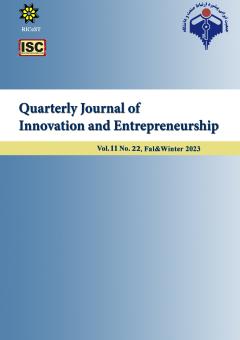-
-
List of Articles
-
Open Access Article
1 - The Impact of Innovation on Economic Growth in Developed and Developing Countries
Mohammad Hassanzadeh Hatef Hazeri Zahra Davazdahemami -
Open Access Article
2 - Designing a network policy model based on the public accountability of the treasury of the Ministry of Economic Affairs and Finance using the foundation's data approach
Maryam Maleki Frogh Roudgarnezhad Samad Jabbariasl -
Open Access Article
3 - Investigating the moderating effect of social capital and environmental uncertainty on entrepreneurial orientation and performance with the mediating role of innovation speed in knowledge-based small and medium enterprises of Razavi Khorasan Province
hossein balouchi Mohammadi Hosseini Seyed Ahmad ehsan mohammadi bajgiran -
Open Access Article
4 - Investigating the effect of Electronic Customer Relation Management (E-CRM) on organizational innovation in government service organizations (Case study: Semnan government counter offices)
Atefeh Falllah Seyed Mohammad Hassan Hosseini Mohsen Lotfi -
Open Access Article
5 - Design and validation of the model of international entrepreneurial orientation in Iranian businesses
Neda Moghaddam Babak Zia Hosein sadeghi Seyed Mojtaba Sajadi -
Open Access Article
6 - The Effect of Technological Readiness and Foreign Capital on Economic Complexity in the Selected oil Countries
Abolfazl Shahabadi Zahra Sadeghi motamed Sanaz Gahrazeh -
Open Access Article
7 - A Model for Developing the University -SME’s Collaboration
Seyed Mojtaba Moussavi Neghabi Morteza Anoosheh -
Open Access Article
8 - Scenarios and Patterns of Future Higher Education in the Horizon of 1410
Reza Mahdi masoud shafiee Ahmad keykha -
Open Access Article
9 - Designing a conceptual model of innovation ecosystem in small and medium enterprises using ISM-SEM
adel ساجدی Houshang Taghizadeh ghaffar tari mojtaba ramazani -
Open Access Article
10 - Evaluating the quality of educational services of the technical faculties of the technical faculties of the University of Tehran based on the headperf model
Mohammad Eslahi hassan mahjub reza eslahi -
Open Access Article
11 - Comparison of the development process in Iran and Japan in the framework of Adrian Leftwich's Theory from 1850 to1900 AD
Ehsan Eilshahi sayyed atollah sinaee Seyyed Khodayar Mortazavi Asl -
Open Access Article
12 - Designing a model of antecedents of organizational entrepreneurship using interpretive structural modeling
Dr. Morteza Moradi Akbar Bayat
-
The rights to this website are owned by the Raimag Press Management System.
Copyright © 2017-2026







